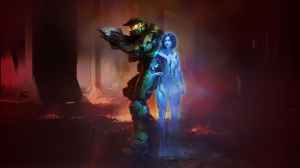Fans now have a brand new way to experience the world of The Witcher with Go on Board’s new board game The Witcher: Old World, and the game has crushed its Kickstarter goal. After I had the chance to try out the game, it’s easy to see why, as it wonderfully incorporates so much of what makes The Witcher fascinating into one deep and satisfying experience. The game runs with its theme, and while you’ll be doing plenty of monster-hunting throughout your adventure, you will also be immersed into a choose-your-own-adventure style narrative in between the thrilling throwdowns – when you’re not playing dice poker or fighting other Witchers, of course.
Videos by ComicBook.com
First, the basics. The Witcher: Old World is a competitive game for up to five players that challenges you with becoming the best and most renowned Witcher around, though you can also play cooperatively in a free expansion if you prefer that experience. In the core game, you’ll choose a Witcher from one of the various Witcher schools including the School of The Wolf, The Cat, The Bear, and more, and each Witcher will feature their own signature skill that will help you get ahead of other Witchers on the trophy track (which happens when you defeat monsters).

There are five Witchers in total, and as you explore the map and encounter creatures, you will train and develop your Witcher’s individual Combat, Defense, Alchemy, and Armor attributes. Raising those attributes will obviously help you in fighting monsters, but will also aid you in fighting other Witchers which you can do throughout the game. These attribute levels will likely fluctuate though because the game is constantly keeping you on your toes and throwing you curveballs through its combat and story mechanics.
For instance, a fight with a monster can net you more than just damage, something I witnessed firsthand in my demo of the game. In this battle, the creature attacking had several attacks that lowered the Defense and Armor levels of my opponent’s Witcher, and that effect is permanent, so to gain that level back, you would need to either find a location to train once again or buy that level back at a Witcher school. The same effect can result from an Exploration card, but we’ll get to those later.
When it is time to throw down with a monster or a Witcher, you will rely on your unique Witcher deck, and that will grow and change as the game goes on. You’ll have the ability to purchase new cards to add to your deck, and these will allow you to do things like pick up shields, attack, use signs, retrieve cards from your discard, and more. Some of these also allow you to combo with other cards.

This is where the combat truly shines, and I was impressed by the strategy and fast pace in the combat overall. When you take on a monster, the opponent pulls the cards from the monster’s Battle Deck, and they can either Charge or Bite. The monster announces their option before pulling their card, and then you read the option you chose when you flip it over. Sometimes the effect is just dealing a certain amount of damage, while other effects do damage to an attribute level or another effect entirely. The Witcher then reacts to the damage or effect and takes their turn, and then it’s up to you on what best serves you in this particular battle.
You might play an Attack card, and if it contains a combo symbol and color, you can then play a card that matches up with that color or symbol. You can build bigger and better combos the more of those you have in your deck, and however much damage you deal takes cards from the monster’s deck, inching it closer to death. After I got the hang of it this back and forth, the combat ended up being extremely fun and rewarding, especially as your deck grows and more options become available, which will happen in phase three of every turn.
Speaking of, the game is split into three phases, and the first phase is moving across the map. Each location on the map has one of three symbols on it to represent its style of terrain, and to move to an adjacent location, you just need to play a card in your hand that matches that symbol. Moving to these various locations will allow you to do things like level up your skill (either for free or with gold), play dice poker, take a Potion card, resolve a quest, and much more, and you can almost always do something in this phase to advance your character or your immersion in the overall experience.

In phase 2 you’ll explore by picking from the Wild Deck or the City Deck which will present you with a story or a quest and ask you to pick from one of two choices. The result could be positive or negative, and you can gain or lose attribute points, potions, gold, or get a lead on a monster trail. If resolved, you will end up with the first turn in that monster encounter which is pretty handy.
Then, you’ll move to the third and final phase: The market. There is a row of cards to purchase that constantly refills, and you’ll discard a number of cards from your hand to purchase one of these, though there is a strategy in this as well. Some cards will cost nothing to pick up, while others will cost more, but as they go down the track (as more cards are purchased), the cost will decrease. So, if you feel like someone else might purchase a card you really want, it might be worth it to spend a little more to get it, but if you risk it, you might be able to get it cheaper.
There’s a lot to love about Old World, though there are things that could be even better. Combat itself is addictive, but some of the elements that make tracking down and eliminating monsters in the video game so strategic and fun could’ve made this system even better. In the games you often have to craft and continually upgrade your weapons and gear to keep pace with the creatures you’re fighting, and while you need to upgrade your Witcher abilities in Old World, there aren’t any crafting or weapon-based systems to speak of.

When it comes to the monsters themselves, while it is a nice touch to have you pick up a monster trail, it only leads to a first turn advantage. It might have been interesting to explore that further, maybe making certain monsters only discoverable if you tracked them through multiple locations. It might take more time and resources to track them down, but the extra effort would gain you bigger rewards. To be fair, this might have slowed things down and hurt the pace overall, but having a little more depth to this mechanic would have been welcome. These are straight up nitpicks though, as you don’t feel like systems are missing in its current form, but they might have added even more depth to an already deep experience.
The Witcher: Old World brings in all of the elements fans love from the franchise and weaves them into one immersive and addictive experience, but it wouldn’t work without a compelling combat system. Thankfully Old World delivers that as well, with an easy-to-learn system that still contains the needed depth to keep the player seeking out battles that feel challenging and satisfying. The narrative hooks give everything an authentic flair that feels second nature to the series, and after spending some time with it, I cannot wait to get this game on my tabletop.
You can check out The Witcher: Old World on Kickstarter right now, and let us know what you think of the game in the comments. You can also talk all things tabletop and Witcher with me on Twitter @MattAguilarCB!








